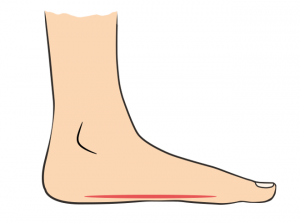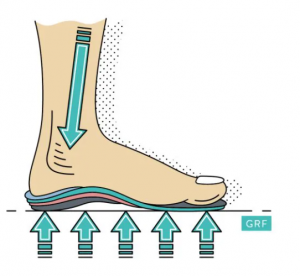therapy for flat feet
Flat feet, also known as flat feet for adults or flat feet, is a painful, degenerative malformation that affects the arch of the foot. Flat feet are caused by tears or fractures in the arch’s soft tissue.
Flat feet, also known as planus deformity, develop when the arch of the foot collapses and the foot comes into full or nearly entire contact with the ground. When the tendons that hold the joints in the foot become loose, the region between you and the arch of the foot flattens. A flat foot is a sloping arc condition in which the sole of the foot is devoid of a bow.

Other issues, such as hip and knee difficulties, can arise as a result of the illness. The disorder can be congenital (present at birth) or acquired (occurring later in life) (developing as a result of age or injury over time).
An injury to the ligaments that support the foot can cause the joints to misalign. Inflammatory arthritis, which affects the rear of the foot, especially the metatarsal, might cause a fall. It does not cause discomfort, but it does cause the foot to flatten and change shape.
If your child’s feet begin to pain, you should take him or her to a pediatric orthopedist. Flat feet that are flexible do not require surgery; however, if your kid has a connected foot or leg problem, such as a torn tendon or more bone fusion of the bones in the foot, or any other ailment, surgery may be indicated. Treatment is not recommended for youngsters who do not develop a bow because the foot can still be stiff and uncomfortable.
Flat feet do not cause pain or other difficulties for many people, therefore there is no need to treat them. Simple devices or exercises can help reduce the discomfort if they create symptoms. If flat feet grow more uncomfortable as a result of usage, your doctor may advise that you rest them.
When a person’s arch or foot is low or non-existent, they are said to have flat feet. Flat-footed people have a low or no arch, so one of their feet is flat on the ground. Many people with flexible flat feet, on the other hand, have an arch that forms when the foot is lifted but disappears when the foot is retracted on the ground.
When a person stands, there is a space between the inner part of the foot and the arch lifted from the floor. This can evolve to a condition known as a stiff flat foot, in which the flat foot’s heel is raised to the right over time.
Some persons can get into difficulty if they appear to have a lesser bow or no bow at all. Inflammation or rips in the leg tendons, particularly the posterior shin tendon that supports the arch of the foot, are a common cause. The arch may not be visible, but it can appear when you lift your foot up.
When you have a neurological or muscular illness like cerebral palsy, muscular dystrophy, or spina bifida, you’re more likely to have flat feet. When the typical arch of the foot grows flat in adults, the posterior shin tendon becomes insufficient.
This is because the ligaments and tendons that maintain the natural arch of the foot are under stress. The tendons in the baby’s foot strengthen with age and help build a regular arch. When looking at an adult foot from the inside, you’ll notice an upward curvature in the middle.
Pes planus, often known as flat feet, is the medical term for it. A high arch characterizes this disease. Most people’s feet do not have flat soles, as you may have noticed.
Reduce painful activities, prevent lengthy walking or standing, and give your bows a break. Your doctor may offer non-surgical treatment if you have foot pain, stiffness, or other issues. Physical therapy can help increase mobility and flexibility by stretching and strengthening tendons and muscles.
To offer your bows extra support, your foot and ankle surgeon can insert a custom orthopaedic device into your shoes. Additional padding in your arch can be provided by over-the-counter arch supports or custom-made orthotics developed by your podiatrist to help improve foot alignment.
To support the bow, encourage your youngster to wear supportive shoes like sandals or flip-flops. Over-the-counter orthotics with bow supports that fit your child’s shoes are made to fit the shape of the foot.
This is intended for flat-footed toddlers who have trouble walking on soft surfaces like sand. To avoid weight transfers, a walking bandage may be required in rare circumstances. People of all ages can benefit from wearing support shoes and orthopaedic equipment.
People with flat feet are treated by aligning their limbs in order to avoid problems. Change your walking style to support your bow if your foot or ankle surgeon prescribes advanced bracing.

If feasible, IDEASTEP Orthopaedics offers a conservative therapy for flat feet that relieves discomfort before it worsens. When the foot glides forward, built-in arch-supported insole orthotics relieve arch pressure and lessen pain. They can help with symptoms, but they may not be beneficial in the long run.
Our podiatrists do a complete foot examination, taking into account the biomechanical function of the foot, to identify flat feet. They will be able to recommend the following treatment stages, shoe selections, and the ideal day or running shoes for flat feet after this assessment. The many surgical techniques available to treat flat feet are familiar to advanced foot and ankle podiatrists who look at conservative treatment choices.
Surgical procedures may include removing bone spurs, mending tendons and ligaments, or fusing one or more bones in the foot, depending on the patient’s condition. Even if the symptoms aren’t severe, it’s recommended to seek treatment as soon as possible after a diagnosis.
